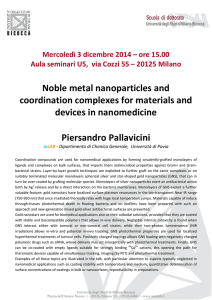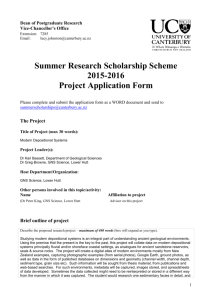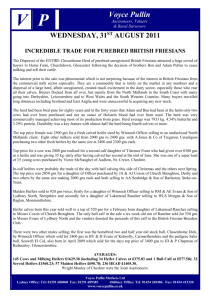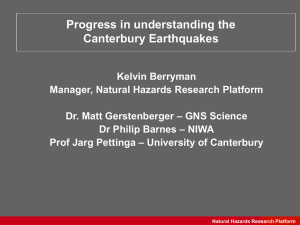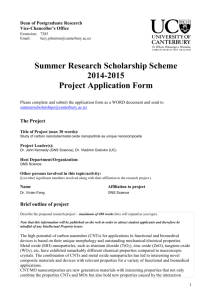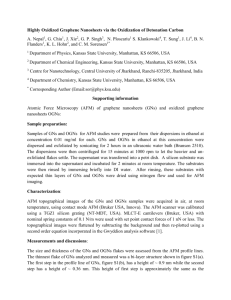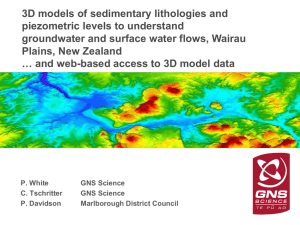Effective policy, decision making and communication for natural hazards
advertisement
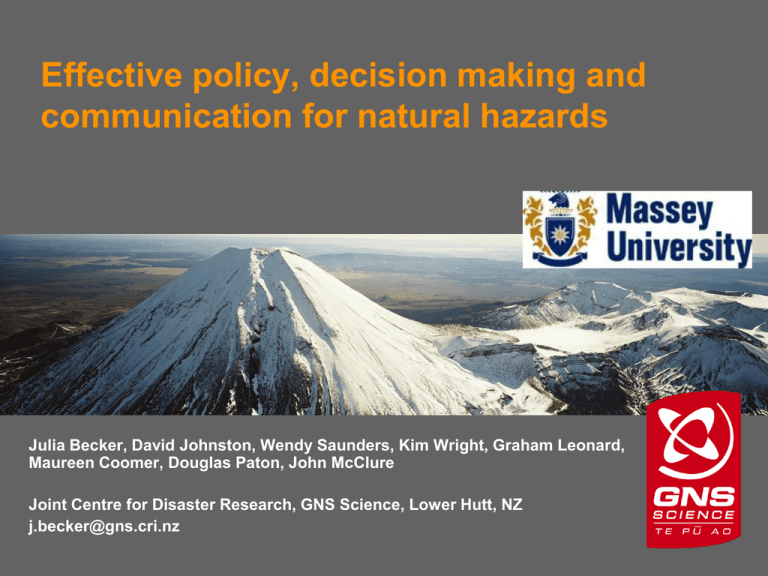
Effective policy, decision making and communication for natural hazards Julia Becker, David Johnston, Wendy Saunders, Kim Wright, Graham Leonard, Maureen Coomer, Douglas Paton, John McClure Joint Centre for Disaster Research, GNS Science, Lower Hutt, NZ j.becker@gns.cri.nz Outline of presentation 1. 2. 3. 4. 5. 6. New Zealand‟s natural hazards Improving policy through integration Improving the incorporation of science into policy Thinking strategically Communication and decision making Summary and conclusions GNS Science New Zealand’s natural hazards Plus severe weather, landslides, flooding, fire and coastal erosion… GNS Science NZ’s last big disaster was over 70 years ago… Napier earthquake, 1931 GNS Science Improving policy through integration • How can we achieve better integration and coordination between the sectors involved in hazard management? and more… GNS Science NZ legislative requirements for managing natural hazards 1. Civil Defence Emergency Management Act 2002 (CDEM) 2. Resource Management Act 1991 (and amendments) 3. Other legislation (e.g. Building Act 2004) GNS Science The 4-R’s of Emergency Management Land use planning Reduction Readiness Recovery Response RMA CDEM Act Other sectors also have a role to play in emergency management, but are not always effectively involved GNS Science Relationships between key legislation for the landuse management of natural hazards Civil Defence Emergency Management Act 2002 Resource Management Act 1991 National Civil Defence Emergency Management Strategy & National Plan Civil Defence Emergency Management Group Plan Local Government Act 2002 Soil Conservation and Rivers Control Act 1941 Local Government Official Information and Meetings Act (section 44A) 1987 Building Act 2004 National Policy Statements Long Term Council Community Plans (LTCCP's) Building Codes Regional Policy Statement Land Information Memoranda (LIM) Regional Plans District Plans Project Information Memoranda (PIM) Non-Statutory Planning Tools GNS Science Improving the integration of science into policy and planning • How can we better incorporate scientific information into planning approaches and documentation? • “We‟re a bit stuck in the TALKING LOUDLY AND CLEARLY MINDSET” – Jenni Barclay • Application of the Active Fault Guidelines “Planning for the development of land on or close to active faults” GNS Science Planning for Fault Rupture Active fault: average recurrence interval of surface rupture less than 2000 years Active fault: average recurrence interval greater than 2000 years or undefined Well defined 0 100 200 km Uncertain gap Distributed GNS Science Ostler Fault Totara Park, Upper Hutt Awatere fault Totara Park – Upper Hutt GNS Science Ohariu Fault Kapiti Coast: Proposed Residential Subdivision OHARIU FAULT and NORTHERN OHARIU FAULT Developed and/or Already Subdivided Sites Building Importance Category 1 2a Fault Complexity 2b 3 4 Resource Consent Category Well Defined Permitted Permitted Non-Complying Non-Complying Prohibited Distributed, & uncertain constrained Permitted Permitted Discretionary Non-Complying Non-Complying Uncertain poorly constrained Permitted Permitted Discretionary Non-Complying Non-Complying 3 4 Greenfield Sites Building Importance Category 1 2a Fault Complexity Well Defined 2b Resource Consent Category Permitted Non-Complying Non-Complying Non-Complying Prohibited GNS Science Key to success to this work • The scientists involved worked closely with planners to apply the scientific information to a planning context GNS Science Improving policy by thinking strategically • How to get planners and emergency managers to think strategically? (“speculation” – Randolf Kent) e.g. What will it be like after the next big earthquake? What do we need to put in place now for recovery to happen? GNS Science Communication and decision making • How can we encourage people to prepare more for hazards? We need to get inside their heads! GNS Science Hazard and preparedness information • Having good information about hazards and preparedness is important. • Dissemination of information as a sole strategy will not be a strong influence on whether people do something about a problem. • The term „information‟ has traditionally been applied to a restricted range of media – need to think laterally GNS Science NZ National Preparedness Colmar Brunton 2009 GNS Science Biases in risk perception Unrealistic optimism: Self-other bias • It will happen to the other guy, not to me. • I‟m better prepared - and more likely to survive. How to counter this? – Tell people positive actions others have taken. 18 GNS Science Biases in risk perception: Denial • Denial - a strategy for coping with anxiety. • More denial when people are vulnerable. e.g. People in unsafe buildings deny risk more. (Lehman & Taylor, 1988) 19 GNS Science Fatalism (Paton & Johnston, 2004) • People think: What can we do? Our efforts are puny. – They don‟t distinguish the hazard from the outcomes. 20 GNS Science Countering fatalism: Present distinctive damage • News media present indiscriminate damage. – focus on catastrophic aspects. – People attribute damage to the hazard. • Instead, also show undamaged [not newsworthy]. – In Northridge, one block collapsed most didn‟t. – People attribute damage to human actions. e.g. building design, levees. – They see the damage as preventable. (McClure, Allen & Walkey, 2001) 21 GNS Science Foster personal responsibility • Programme - increase readiness for volcanic activity (Paton et al., 2001). – People thought the Council was acting. – Attributed responsibility to the Council. – Led to decrease in preparation. • Must spell out responsibilities. 22 GNS Science Model for community resilience GNS Science Future efforts must address factors at three levels: Personal level – Develop people‟s problemsolving skills (action coping). Their belief in the benefits of hazard mitigation (outcome expectancy). Their ability to confront hazards (reduce negative outcome expectancy). GNS Science Community level – Encourage active involvement in community affairs (community participation). Develop community ability to resolve collective issues (articulating problems). Institutional level – Develop an individual‟s ability to influence what happens in their community (empowerment). Improve the level of trust they have in organisations (trust). GNS Science Effective warning systems • How to develop effective warning systems • Warnings are not just about hardware – they are part of a decision-making process! • Need hardware, planning, cooperation, communication, education, participation, exercises (Leonard et al., 2008). GNS Science In summary…lets move from… Communication to Collaboration, participation and engagement GNS Science
